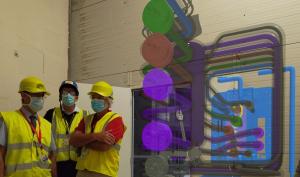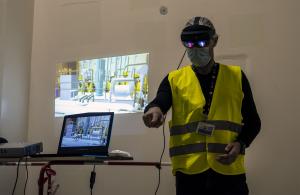Évaluer le futur environnement de travail
Deux paires de modules de couverture expérimentaux, développés et fournis par les membres d'ITER, chacun basé sur une technologie spécifique, seront intégrées à la paroi interne de la chambre à vide. De taille relativement modeste (1,7 mètre de haut sur 60 centimètres de large), l'élément face au plasma de chaque module s'insère dans une structure nettement plus importante pesant près de 45 tonnes.
Tous les deux ans, pendant la période d'arrêt, deux structures massives, contenant chacune deux modules de couverture expérimentaux, devront être retirées afin de réaliser une analyse en profondeur des éléments face au plasma.
Quand bien même les opérations de manutention seront automatisées et pilotées à distance, l'intervention humaine sera parfois indispensable. Les cellules étant situées à proximité immédiate de la machine, elles auront été exposées au plasma pendant plusieurs mois, et la présence d'opérateurs, même spécialement équipés, devra être limitée de manière à réduire leur durée d'exposition au strict minimum.
Les systèmes de couverture expérimentaux, qui seront installés quelques années avant le lancement du fonctionnement à pleine puissance, sont actuellement en phase de conception préliminaire. « Nous disposons de plans, de modèles 3D, mais pour optimiser notre approche, il nous en faut plus », explique Jean-Pierre Martins, ingénieur de maintenance à la Section système de couverture tritigènes d'ITER.
Ce « plus » est une nouvelle approche développée par les experts du CEA : la réalité « augmentée » ou « étendue ». Fondée sur des bases de données 3D, la réalité augmentée permet de créer une immersion dans l'environnement futur des cellules, en combinant et superposant des éléments virtuels aux structures « réelles » telles que les portes, les parois et les galeries. Équipés d'un casque de réalité virtuelle (tel que le HoloLens de Microsoft), les concepteurs du système, experts et décideurs peuvent ainsi participer à la même simulation, explorer ensemble la future configuration physique de l'environnement des cellules, et partager une approche commune de l'environnement et des conditions de travail.
Prendre la mesure des contraintes qu'imposera l'environnement est essentiel pour optimiser les interventions des opérateurs. « Nous visons une efficacité maximale et une exposition minimale, conformément au principe ALARA (As Low As Reasonably Achievable ou aussi faible que raisonnablement possible) qui régit l'exposition aux rayonnements dans les environnements nucléaires, précise Jean-Pierre Martins. Ainsi, lorsqu'elle est utilisée dans les premières phases de conception d'un système, la réalité augmentée constitue un outil très prometteur. Au-delà de son application aux modules de couverture expérimentaux, elle peut être étendue à l'ensemble du programme. »
Ces dernières semaines, le directeur général d'ITER, les chefs de Domaine et divers responsables ont coiffé le casque magique et plongé dans ce monde étrange où se mêlent réel et virtuel. Ils ont pu mesurer le potentiel de la réalité augmentée dans la planification de l'avenir.
Cliquer ici pour visionner une vidéo des essais.
* Signé en 2009, l'Accord de soutien sur site établit et définit la relation entre ITER Organization, le Commissariat français à l'énergie atomique et aux énergies alternatives (CEA) et l'Agence Iter France.




